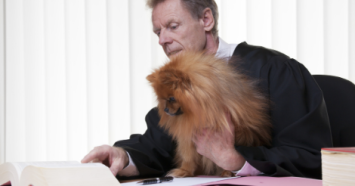
Dogs are finding new roles inside courthouses in the United States. Currently, 47 specially trained assistance dogs work in 21 states, providing emotional support to witnesses while they testify.
It is a relatively new practice. Witnesses cannot simply trot into a courthouse with their dog – or any dog – in tow. Attorneys must petition judges for permission to use a trained assistance dog with specific witnesses in specific cases. Common scenarios, where attorneys might make such a request, include adult or child victims of violent or sexual assaults and witnesses who fear the accused.
What Are the Requirements?
Trained from puppyhood by accredited assistance dog organizations, courthouse dogs must be capable of doing the following tasks:
Remain quiet, still, and unobtrusive as the witness gives testimony
Hold a steady sit or down position next to the witness for an extended period of time in court
Never exhibit behaviors that would be distracting to anyone in the courtroom
Often, it works best when the witness and the dog can meet in advance during pre-trial meetings and interviews, for example.
Are Courthouse Dogs the Same as Therapy Dogs?
Courthouse dogs are not typical therapy dogs, like the ones visiting hospitals and nursing homes. Courthouse dog handlers are usually on staff with an agency related to the justice system, and the handlers do not sit with or cue the dog during testimony. Dogs must be able to remain steady, calm and useful even if the witness cries, yells, stands up suddenly, and the like. Often the witness simply holds the leash during testimony.
Because courthouse dogs are so new, agencies that use them are extremely careful to prevent problems with the dogs and to follow all the legal rules and requirements. Just one bite or bad outburst by a dog in a courtroom could undo years of work and reputation building.
An Impartial Pup
To protect the judicial process, judges instruct juries “not to make any assumptions or draw any conclusions based on the presence of the dog.” In some cases, defense attorneys object to the dog on grounds of distraction, prejudice, and even allergies. Some attorneys have filed appeals, arguing that the dog swayed the jury. Courts in Washington State denied one appeal, comparing the use of a courthouse dog to a child witness holding a doll or other comfort item on the witness stand.
Advocates point out that a dog lying quietly near the witness– often outside the jury’s view – might even be less obvious than clutching a doll.
Some police departments have added assistance dogs to their rosters to help when interviewing witnesses, especially young ones. In some cases, the only way victims or witnesses can or will take the stand is with a courthouse dog at their side. Both sides want to avoid a mistrial or retrial situation, so the requests for courthouse dogs must be carefully targeted and truly necessary.
Tell Us What You Think
Would seeing a dog providing support to a witness in a courtroom sway you? In what situations would you want to have a dog at your side in court?
Resources
O’Neill-Stephens, Ellen. “Courthouse Dogs: A Case Study,” Animal Law Committee Newsletter, September 2009.
“Using a courthouse dog in the courtroom,” www.courthousedogs.com Case No. 66549-9-I, State of Washington Court of Appeals, August 27, 2012.